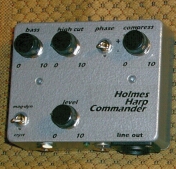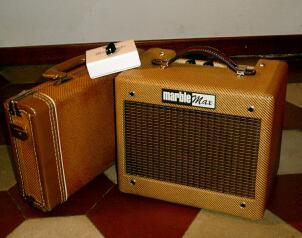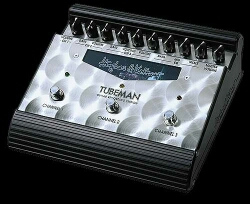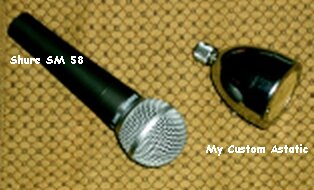Shaping that Loud Harmonica Tone
by Gianandrea Pasquinelli
Pioneers of electric harmonica have overcome great obstacles to make their instrument louder than drums and guitars. These visionaries were hampered by mics and amps developed for other uses (vocal & guitar) and by a generally negative attitude toward their little instrument. Today many things are changed and there are a few manufacturers paying attention to the harmonica market. We have reviewed four types of tone-shaping units; two are harmonica specific (i.e., harmonica commander and Marble Max & Magic Mic) while the others are a general purpose studio unit (JoeMeek VC3 Pro) and a guitar tube pre-amp (Hughes & Kettner Tubeman Rec. St.). All units are top quality, well built gears providing distinct harmonica sounds to the demanding harp freak; the tonal response ranges from full clean tones useful for folk/country/jazz songs to compressed tones suited for electric blues to wild distorsions ideal for the rock arena; so the choice is yours, listen to the examples and let me know what's your favourite tone.
JoeMeek VC3 Pro
Mic preamp - photoelectric compressor - spectral enhancer
Wave
This is a half-width 1 U unit consisting of a high-quality mic preamp, a photoelectric compressor stage (due to the nature of the optics, the photoelectric compressor is not very fast; this feature gives a smoother and more subtle compression effect when compared to the more conventional circuits), and a spectral enhancer which gives some sparkle to the final sound.
Manufacturer: JoeMeek, Torquay, England

Editorial note: The VC3 Pro is not longer in production !!
Test Conditions and Parameters.
Test performed on 12/8/2002; harp: Hohner special 20, A tuned; player: G. Pasquinelli; song played: "Honeydripper"; technique: open hands (no cupping at all), harmonica played 10 cm from the capsule; microphone used: Shure SM 58 plugged straight into the JoeMeek input; JoeMeek settings as follow: mic gain (clock time) 16, compressor on, compressor (clock time) 14, release (clock time) 10, attack pushed on, enhancer drive (clock time) 10, Q (clock time) 10, enhancement quantity (clock time) 12, output volume (clock time) 16. USB Audio Capture Edirol UA-5: sampling frequency 48 kHz, gain (clock time) 12. Recording Software: Cooledit Pro 2.
Results
please read the note at the end of the page

Comment: natural tone with a bright edge; subtle compression; plenty of dynamics; many harmonics; the unit is very versatile and accepts both low balanced and high impedance unbalanced mics (i.e., you can use any kind of mic you own), as well as line level signals (i.e., you can use it with effect processors, overdrive pedals, etc.); overload control through a series of leds; two independent outputs available at the same time useful for monitoring (monitor on stage) and PA injection, the insert input makes possible the use of an external effect unit (Y cable); excellent cost/quality ratio; useful on stage and at home (for recording).
Harmonica Commander
Mic preamp - compressor - phase selector - equalizer - feedback reduction
Wave
This is a Swiss army tool for the harmonica player. This hand-made little box accepts dynamic, magnetic, crystal hi-Z mics (the most used harp microphones, e.g. Astatics, Shure 520) and matches their impedance to that of the guitar amp inputs; the unit has a built in compressor and a phase switch which used in conjunction with a high filter cut minimize usual feedback problems; a bass boost lets the harmonica low end to shine.

Manufacturer: Ron Holmes, Bakersfield, CA, USA
Test Conditions and Parameters.
Test performed on 12/8/2002; harp: Hohner special 20, A tuned; player: G. Pasquinelli; song played: "Honeydripper"; technique: tight cupping; microphone used: personally customized Astatic crystal capsule plugged straight into the harmonica commander input; Harmonica Commander settings as follow: crystal switch on, level (clock time) 9, bass boost (clock time) 11, high cut (clock time) 0, phase -, compressor (clock time) 11. Line-out to USB Audio Capture Edirol UA-5: sampling frequency 48 kHz, gain (clock time) 0. Recording Software: Cooledit Pro 2.
Results
please read the note at the end of the page
Comment: rich, well-balanced, moderately compressed tone; emphasis on the middle-midrange of the instrument; even harmonics; the unit accepts any kind of high impedance mics; for vocal low-Z mics use a mod is required (ask Ron); perfect impedance matching which makes this unit valuable in front of any guitar amp; good feedback rejection; two independent outputs available at the same time useful for monitoring (inst. output to the monitor amp on stage) and PA injection (through line-out); very useful on stage and good for home recording.
Marble Max & Magic Mic
Harmonica Tube Amp with line-out & crystal mic impedance optimizer
Wave
Marble Max: very simple, compact, hand-made, cathode biased, tube amp: one input; two knobs (volume and tone); main switch; jewel pilot lamp; transformer tapped line-out. The circuit (point to point wiring) is based on a vintage Fender tweed Champ with some mods to fit the harp requirements. It delivers 6 W through a specially designed ceramic 8 inch Weber speaker. Tube layering: EZ81 (rect.), 12AY7 (pre-amp), 6V6 (power). It can accept a 6L6GT without any bias adjustment.

Magic Mic box: op amp based circuit which optimizes crystal mic impedance to that of the amp input; the result is that the output of the element increases simulating the drive of a controlled reluctance element still retaining the punch of the crystal cartridge with more focused basses.

Manufacturer: Marble Amp, Holland.
Test Conditions and Parameters.
Test performed on 12/8/2002; harp: Hohner special 20, A tuned; player: G. Pasquinelli; song played: "Honeydripper"; technique: tight cupping; microphone used: personally customized Astatic crystal capsule plugged straight into the Magic Mic set to (clock time) 12 then to the Marble Max input; Marble Max settings as follow: volume (clock time) 14, tone (clock time) 11; speaker disconnected (yes it is possible with no problem); Line-out to USB Audio Capture Edirol UA-5: sampling frequency 48 kHz, gain (clock time) 0. Recording Software: Cooledit Pro 2.
Results
please read the note at the end of the page
Comment: warm tube distorsion; high compression; many overtones; good sustain; tonal palette focused on the lower to upper midrange of the instrument. Thanks to the line-out, Marble Max can be successfully used on the stage (as a stage monitor) while injecting the tone to the PA system. By disconnecting the speaker it can be used as a pre-amp/power amp tube saturation unit for direct recording (as in the present example). Highly useful on stage and good at home (for recording).
Hughes & Kettner Tubeman Recording Station
Instrument tube preamp - 3 independent channels - equalizer
Wave
Rugged pedal operated on a 12AX7 tube, featuring 3 channels with silent and real-time switching. The EQ section (bass, md, treble) is tailored on guitar and affects all channels. Each channels provide separate controls and increase amounts of distorsion. A master volume affects the overall signal which is routed through an "output to power amp" and an "output to mixer"; this latter signal is frequency compensated with an integrated "Red Box" circuit.

Test Conditions and Parameters.
Test performed on 12/8/2002; harp: Hohner special 20, A tuned; player: G. Pasquinelli; song played: "Honeydripper"; technique: tight cupping; microphone used: personally customized Astatic crystal capsule plugged straight into the Magic Mic set to (clock time) 12 then to the Tubeman Recording station input; H&K settings as follow: Ch 1 gain (clock time) 9, Ch 2 gain (clock time) 10, volume (clock time) 13; Ch 3 gain (clock time) 9, voicing (clock time) 12, volume (clock time) 12; EQ: bass (clock time) 14, medium (clock time) 12, treble (clock time) 12; master (clock time) 16. Output to amp (no frequency compensated) to USB Audio Capture Edirol UA-5: sampling frequency 48 kHz, gain (clock time) 0. Recording Software: Cooledit Pro 2.
Results
- H&K Channel 1 MP3
- H&K Channel 1 RA
- H&K Channel 2 MP3
- H&K Channel 2 RA
- H&K Channel 3 MP3
- H&K Channel 3 RA
please read the note at the end of the page
Comment: a little bit harsh tube distorsion; low to high compression (compression increases with stages of distorsion); many uneven harmonics; extreme sustain; tonal palette extending from the lower midrange to the lower trebble of the instrument (maybe it needs more treble cut than I did). Although the H&K Recording Station can be used on the stage (by using the output to amp monitor) while injecting the red box fitted output to the PA system, it gives its best at home. Note that the frequency compensated output is not well suited to the harmonica requirements (results not shown) and its range of distorsion is not for every taste.

